Earlier this year, I got through my second hernia repair. Perhaps it is due to my age (41), but this time around I found the procedure fascinating, so I set out to learn more about it. This post will review my knowledge about the male Hernia, why and where they happen, and I will go through some advice on what to expect, along with some ideas on how to heal up quickly.
This is pretty personal stuff and not my normal sort of post. Yet writing is an art form, it can be fun, and it can be informative. So most importantly, once this post is indexed by Google, I hope it can provide some insight to other men who may be having a Hernia repaired in the future. I looked around myself finding lots of cold, technical, medical advice but very little writing about actual experiences that I might learn from.
Please be warned that I am not a doctor. Therefore, this is not medical advice, I am simply sharing my experiences over several weeks of healing and learning.
The typical male hernia happens due to a weakness in the abdominal lining, which is a set of muscles that keeps the intestines tightly wound up inside the abdomen.
The weakness is usually there due to a birth defect, in places where one might expect the abdomen wall to be weak or thin.
The belly button is where I found my first hernia, 6 years ago. The belly button is the remnants of the umbilical cord which fed us while we were inutero. That umbilical cord was cut off long ago but the procedure often leaves an imperfection in the abdomen wall.
In my case, I was losing weight and one day noticed that my belly button was an "outey". I could push my belly button in but then after a cough or any sort of pressure on the abdomen, it would pop out again. Suddenly, I could perform party tricks!
Wikipedia provides a nice graphic here to illustrate the issue, as it appears under the skin.
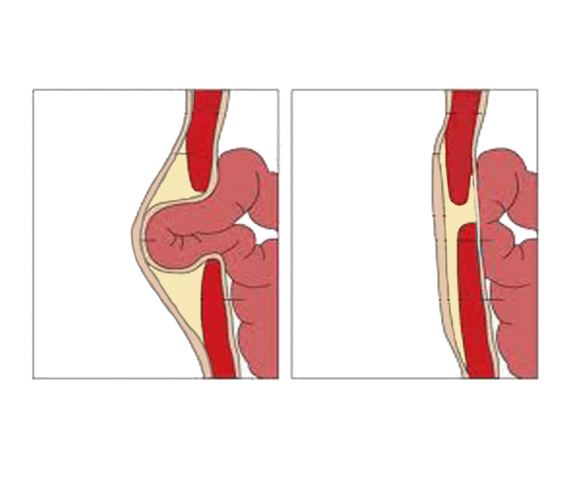
In my second case, I suffered from a Inguinal Hernia. This is very common in men because of the way that men's testicles develop. Inutero, male babies have testicles in their abdomen. The testicles descend from the abdomen, usually before birth, leaving small imperfections in the abdominal wall. Additionally, I have read that there are still nerves, blood vessels, and other connections to each testicle from these same points in the abdomen wall as adults.
So here are two more areas where the abdomen is often weak and where men can easily put too much strain on the area resulting in a hernia.

So hernias in men, are many times the result of some sort of birth defect combined with straining that area, likely by doing some sort of heavy lifting.
Wikipedia indicates there are over 1.5 million hernias repaired each year in the US alone.
When I spotted both Hernias, the General Practitioner in each case was very sympathetic to my schedule saying, "if it doesn't hurt, you don't need to get it fixed right now."
Then my GP walked off to another patient and lost all interest in me.
This is also very common, the hernia may not hurt at all and in occupations where there is a lot of heavy lifting, the hernia repair could bring a person out of work for often up to 4-6 weeks. So many men elect to do nothing for a number of years, maybe even until retirement.
The problem I had with waiting is that I am a very active 41 year old dude. I have numerous trees I am planning to cut down, chop up, I even need to get the stumps out of the ground this summer. I workout every day, I swim, I fish, and do all sorts of activities that began to worry me.
I was worried that my hernia would get worse with my active lifestyle. Furthermore, with the docs all asking me if it hurt, it eventually lead to a dream. In this dream my hernia began to hurt so badly, that I yelled for my wife to call the ambulance! Fortunately, it was only a dream, a strange dream that involved pain unlike any dream I have ever had before, and it scared the crap out of me.
Other than pain, that I never experienced, there are some other issues that can arise if a hernia goes unaddressed. If the hernia gets worse, it can actually pinch the intestines causing a blockage, or it can even kill off a section of intestines which can lead to all sorts of problems including death.
Furthermore, the older I get, the harder it seems to come back from surgery.
This is an image of my belly after my 2nd hernia repair a few weeks ago.
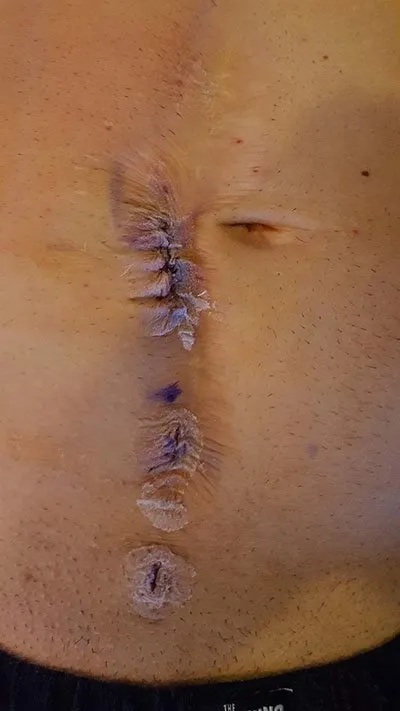
As you can see, I have had lots of work done on my abdomen. When I was in the 7th grade, my Appendix burst, which is another post all together but you can see my old scar from back then.
So my abdomen has been opened up by doctors 3 times in my life and I have the scars to prove it.
When I was in the 7th grade I remember bouncing back quickly and with little to no pain medication. That particular surgery was far more invasive and critical too. But thinking back about it, I don't really remember any pain or serious struggle.
My 1st Hernia was repaired in 2011 and there was a significant amount of pain that I dealt with.
This time around, it feels terrible, it has been quite a struggle and I do not wish to imagine what it would be like 20 more years from now.
So I am a fan of abdominal surgery, it has saved my life as a kid and helped with 2 hernias as an adult. Some folks are scared of it, and they may have their reasons but I have mine too. I work on a computer all day, I do not need to do any heavy lifting as a part of my daily job so I don't have those issues to worry about. I didn't want to risk any further complications and I am not getting any younger.
Which is why I decided not to wait any longer.
I read a lot about Laparoscopic surgery and found it rather fascinating. Another benefit of addressing a hernia early is that it can often be repaired using a Laparoscopic Surgery, which is much easier to get through and far less painful than traditional surgery.
The image below from Wikipedia shows a Laparoscopic surgery taking place on the abdomen. Notice how the abdomen is not really opened up. Not only does this help reduce the pain but it helps avoid numerous complications that go along with fully opening up the abdomen.

There are usually 3 small holes made, one for the camera, one for the left hand, and another for the doctor's right hand. Using tools to extend their reach, the doctor's can work inside the human body, look around using the camera, all without opening it up.
Below is a close up of the "arms" that the doc will use inside the body.
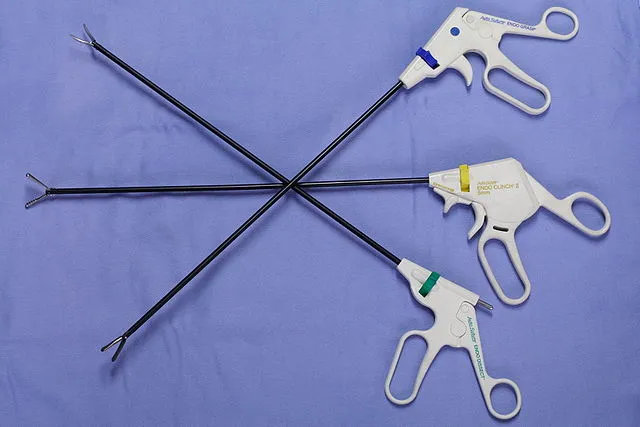
Wikipedia indicates that some doctors will remotely control a robot to do the work entirely. I find this to be some absolutely fascinating technology.

In both cases, my hernia was repaired using a mesh patch that gets stapled into the surrounding muscles. In the case of my 2nd hernia, the doc never technically had to open the abdomen wall at all. He was able to slide his scope and his little robot arms between the muscle groups as they are often layered over one another, so that he could place my mesh patch into the correct location on the outside of my abdomen wall.
My first hernia was different, the patch in that case was placed on the inside of the abdominal wall which required the doc actually get inside the abdomen.
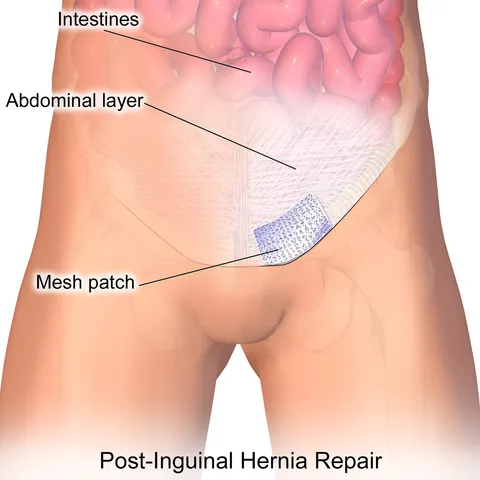
The mesh is very high tech and very modern made of polypropylene, polyester, and teflon. The doctor said it would be around longer than I am and that my body would grow tissue, including muscle all around the mesh.
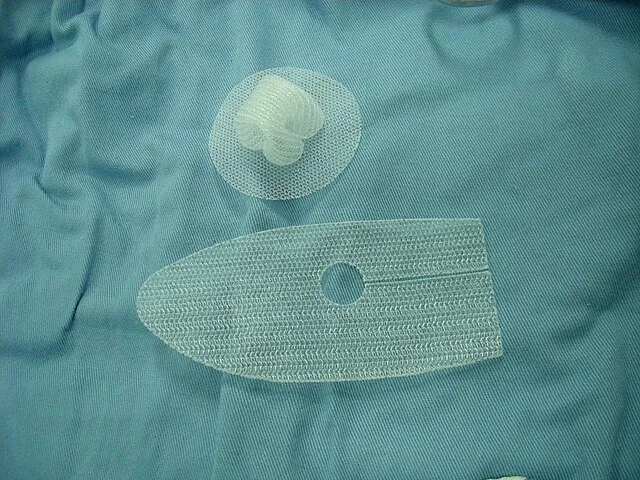
The staples that lock the mesh into place for the first few months will eventually dissolve but by that time other tissue should have grown around the patch locking it into position for the rest of my life.
In both cases, for me, it is those staples that hurt more than anything else. My incisions did not really hurt but the doc said those were fairly superficial. When I pointed to where the pain was, he explained that it was where he had attached the mesh to my muscles using some sort of bio-degradable staples.
OUCH!
Wikipedia goes through the entire history, which indicates that prior to Laparoscopic Surgery, the abdomen did need to be opened up entirely to repair the hernia. Furthermore, prior to high-tech patching material, the doctors used to simply suture the opening closed. Wikipedia went on to discuss extended healing periods where no heavy lifting could be done.
Further research in the topic showed studies about what happens when a person with a recently repaired hernia does decide to lift heavy weights anyway.
I read about a studies starting out in the 1890s, then in the 1940s, again in the 1970s, and another time in the 1990's where the researchers monitored the number of days off doctors prescribed, how many days were actually taken off, and what the effect was.
Amazingly, the article went on to discuss the details of a study conducted for people who went back to heavy lifting with only 1 day of rest after the surgery! Fortunately, there were no deaths reported as a result but in large, the biggest issue involved with not getting enough rest, was that the hernia needed to be repaired again at a future date. I really feel sorry for those folks but according to the article, it looks like they volunteered for the research.
The article seemed to summarize that among all doctors interviewed over the course of time, even recently, the very least that any doctor recommended was 1 week off of work, no matter what job you do. Depending on the patient, the doctor will prescribe different length of time but not one single doctor in these studies ever recommended anything less than 1 week off of work.
The day of the surgery, I went home in the early afternoon only a couple hours after my surgery was complete. I was pretty miserable. I found it impossible to stand up straight and using my abdomen for anything was enough to bring tears to my eyes. Getting up and going to the bathroom required help. Putting underwear and socks on required help. Rolling over required help and Hydrocodone really did take the edge off of the major pain.
Noticeably better than the prior day. I was able to get to the bathroom on my own but getting up still required a bit of help. There were no more tears after day one but I was still very slow moving. I managed to do the steps in my house once, it hurt and I refused to go downstairs again that day. Still on pain meds.
Things were better than the prior day once again, but I was still in lots of pain and moving around very slowly. I originally thought I would be able to go back to work on this day but there was just no way it was going to happen. I did not take enough time off work and this resulted in a last minute request for more time off of work. I requested the rest of the week off.
Noticeably better than the prior day. I was able to use the restroom on my own all day no problems, but I still needed help with my socks. I was still taking 2 pain killers per day and riding in an automobile really hurt. So I was unable to drive myself anywhere. I worked from home for 6 hours on this day and did pretty good getting some stuff done.
Noticeably better than the prior day. I went to work for one hour to see how I did in the car but I did not drive because I was still on pain killers. This was the first day I was also able to put my own socks on all by myself! YEY!
So I noticed a huge difference each morning feeling much better than when I went to sleep the day prior. However, by the end of each day I was falling apart, hurting everywhere and very tired. But a good night's rest always brought more relief.
Days 6 and 7 were over the weekend where I stayed in all weekend getting more rest.
I was back at work the following week full-time and my doctor cleared me for Physical activity on the 8th day in the afternoon. I will not see the doc again unless there is a problem.
I am off of pain killers. I still get tired very quickly in the evenings going to bed around 7:00. The pain pulls and tugs at my waistline occasionally forcing me to bend over.
As the pain in my abdomen started to melt away, I began to feel the pain in my back setting in. Two weeks hunched over caused two major cramps running up either side of my spine. This is not normal back pain. I have had back pain before and it sucks, but this was different, it was more like a really bad back cramp but it was enough to keep me up at night.

For anyone who is looking into such an abdominal surgery, I might recommend some exercises to strengthen and condition the back for what you are about to put it through.
This landed me in the Chiro's office for two visits. I know some folks do not believe in Chiropractic Practices and you are free to believe what you want. However, if you are in serious pain, it is worth a try. The Chiro can be very therapeutic, at the least. Also, my Chiropractor's office contains a professional masseuse. I highly recommend setting up visits with the Chiro and masseuse to address any back pain that you may have left over from an abdominal surgery. It really makes a huge difference to me.
The typical MD in this country will rarely, if ever, recommend you see a chiro, masseuse, nutritionist, or acupuncturist. I do not think they would recommend against it, they just leave that choice up to you. Likely for legal reasons.

I have found great value in all those forms of therapy.
After my first hernia repair, I went to the Acupuncturist. Some surgical procedures will fill up the abdomen with gas so the doctor can work inside the body with a little more room. They don't always get all the gas out and it can make a person feel very bloated. So I used acupuncture to help release the gasses trapped in my abdomen from surgery, but also for pain and healing.
So the typical American MD may not be a true believer, but in 2/3 of the world... Acupuncture is SCIENCE!
Lastly, pain medications can clog up the pipes, many times causing constipation. The nutritionist can help with that offering pro-biotics, digestive enzymes, and even Aloe Vera pills that can speed up the bodies natural healing process. The doctor's office told me I would not poop for many days after the surgery, so I got started supplementing my diet right away.
These therapies may not be the answer to everything, but take them for what they are worth. There is value here and you may not need to suffer.
Getting on Enzymes and pro-biotics on day one helped me a great deal and I never suffered any side effects of the opiates.
Coughing was totally miserable. I had 3 incisions below my belly button and it is amazing how many things we do require that section of the abdomen. I quickly learned that coughing does not come from the lungs. All coughing starts out below the belly button working that section of the body very hard. So I started to perfect a new type of cough that started out in the lungs rather than the abdomen. If you are going in for this sort of surgery I might suggest that you practice coughing like this ahead of time so you can get used to it.
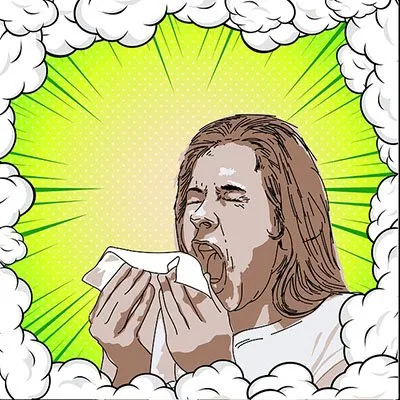
I found that I could fill my lungs with air and hold it for a minute to help some pressure build, then without any action from below my belly button, I could let the air out of my lungs very quickly. This was not a cough, it doesn't really sound like a cough nor is it as productive. However, it did allow me to clear my throat when needed without passing out due to the pain.
Even something as simple as breathing caused pain over the first few days. When I was relaxed I noticed that I would breathe through my belly, meaning that my belly would flex in and out with each breathe. When my heart rate is up, I would breathe through my chest. I was not working out much at all in this condition so it left me breathing through my belly a lot, which hurt. Here again, I tried to breathe through my lungs, which is harder and it often sounded like I was out of air when I would talk. This also left me totally unable to yell or project my voice much at all. Again, yelling comes from right below the belly button, so be prepared to speak softly for a few days.
Sources:
https://en.wikipedia.org/wiki/Hernia